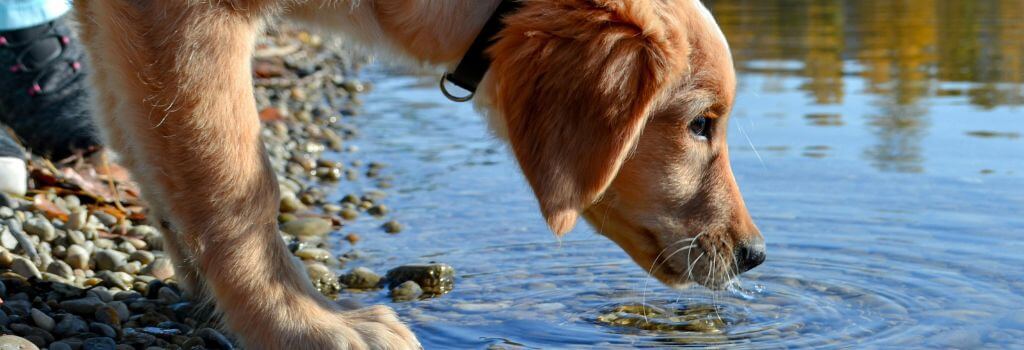Do you have a dog that loves swimming, splashing in puddles, or jumping into any pit of mud that they can find? In addition to leaving you with a whole lot of cleanup, these activities could also be putting your dog at risk for a serious – and potentially life-threatening – illness known as Leptospirosis.
With rising temperatures, increasing rates of rainfall, and more frequent flooding in areas around the country, leptospirosis is becoming a growing concern for pet owners and veterinarians. Whether you live in the suburbs, city, or countryside, understanding how leptospirosis is spread, diagnosed, treated, and – most importantly – prevented can be instrumental in protecting not only your dog’s, but also your family’s health.
What Is Leptospirosis in Dogs?
Leptospirosis is a zoonotic disease – that can be transmitted from animals to humans – caused by a spirochete bacterium of the genus Leptospira. Leptospira thrives in water and has a helical or spiral shape with a characteristic hook on one or both ends. There are many serovars (strains) of Leptospira, four of which are the most clinically important: L. Canicola, L. Icterohaemorrhagiae, L. Grippotyphosa and L. Pomona.
Leptospirosis can be referred to by a number of different names, including Weil Disease, Fort Bragg Fever, Autumnal Fever, Swamp Fever, Mud Fever, and Hemorrhagic Jaundice, just to name a few. However, despite the different names used around the country, the hallmarks and dangers of the disease remain the same: an infection in dogs that can cause severe damage to the kidneys, liver, and blood vessels and may be fatal in serious cases.
This infectious disease poses a significant health concern for humans and our dogs. It is the most common zoonotic disease occurring in the world – particularly in areas that are experiencing increased rainfall. In recent years, the Centers for Disease Control and Prevention has warned both individuals and pet owners alike that infection risks are growing across the globe, especially in areas prone to hurricanes, heavy rain, and flooding.
How Is Leptospirosis Spread?
While leptospirosis is often transmitted directly between reservoir hosts through bite wounds, ingestion of infected tissues, or sexual secretions, most pets and humans actually become infected with leptospirosis through contact with a contaminated environment. This most commonly occurs when the skin or mucous membranes come into contact with urine-contaminated soil and water.
While staying away from dirty areas or bodies of water may sound straightforward, contaminated soil and water are more common than you’d think. Leptospires are harbored in the kidneys of reservoir hosts like deer, opossums, raccoons, rodents, skunks, and other wildlife. These hosts excrete Leptospira into the environment through their urine over long periods of time, thus effectively contaminating the environment.
Urine-contaminated soil and water can remain infectious for months, only making the threat of leptospirosis in dogs much more real and pressing. Swimming in ponds, lakes, and streams poses an increased risk for exposure to leptospirosis, as local wildlife hosts commonly contaminate these water sources. So, if your dog swims in a contaminated lake or rolls around in contaminated mud with cuts or scrapes on their body, they are at risk of becoming infected with leptospirosis.
Where Lepto Is Commonly Found
Leptospirosis has a worldwide distribution and is found in most regions of the United States. Typically, this disease is thought of as a disease of the tropics and subtropics (our climate zone here in Charleston, SC); however, the disease is found commonly in the Northeast and most of the US.
Generally, leptospirosis can be found wherever there is sufficient rainfall, non-freezing temperatures, and the presence of host animals. Due to climate change and shifting temperatures, experts predict that an increase in rainfall in the southeast region of the United States could be a cause for concern in relation to cluster outbreaks of leptospirosis.
How Common Is Leptospirosis In Dogs?
Although it is not a federally reportable disease in the United States, Leptospirosis is the most common zoonosis in the world and is a common cause of acute kidney disease in humans. In dogs, leptospirosis is a little more uncommon mostly due to awareness, prevention, and vaccination, though specific data regarding the number of cases diagnosed in dogs annually isn’t available.
However, just because leptospirosis isn’t as prevalent as it once was, thanks to proper vaccination in many communities, that doesn’t mean it isn’t something dog owners can ignore. It is still a very real and serious threat to all dogs in the United States, as well as their owners and families.
To lessen the risks of pets in our area contracting this preventable disease, we’re dedicated to educating our clients so that they have an awareness of the disease, know how it is transmitted, and fully understand prevention options like vaccination.

Dogs That Are at Risk for Leptospirosis
Owners are often curious if their dog is at risk or if leptospirosis is really something they need to worry about, and the simple answer is this: All dogs are at risk of leptospirosis.
Regardless of age, breed, lifestyle, geographic location, or time of year, any dog can contract leptospirosis, making it crucial for dog owners to understand how the disease is transmitted, as well as how symptoms will present in affected dogs.
Some behaviors and lifestyle factors can increase a dog’s overall likelihood of contracting lepto during their lifetime. These factors can commonly include:
- Dogs that spend much of their time outdoors are at a higher risk than those that live mostly indoors.
- Dogs living in suburban and rural areas are more likely to be exposed to wildlife and soil contaminated by urine. However, the risk of exposure is still present in urban life.
- Dogs who are around livestock are more likely to be exposed due to the non-clinical carrier states of the livestock as well as the presence of rodents.
- Dogs participating in activities involving lakes, rivers, streams, and ponds are more likely to be exposed. Outbreaks or clusters of cases often occur associated with heavy rainfall and flooding.
Leptospirosis Symptoms to Look for in Dogs
Clinical signs in dogs with canine leptospirosis are often non-specific and can include:
- Fever
- Lethargy
- Weakness
- Muscle tenderness
- Anorexia
- Vomiting
- Excessive urination
- Abdominal pain
Many of these symptoms will manifest as a result of sudden kidney injury, liver dysfunction, or other organ damage caused by the bacteria.
Identifying a leptospirosis infection in dogs based on symptoms alone can be difficult, as the clinical signs of lepto in dogs are highly variable, with some dogs presenting with several common symptoms, while other dogs will express no obvious signs of an infection.
In fact, most experimentally infected dogs show no overt clinical signs or symptoms of leptospirosis. The percentage of naturally infected dogs that show no signs or non-specific signs is unknown, but the key to recognizing symptoms or when something might be amiss with a dog is to consider the environment in which they live and the risk of exposure they may have. Any dog that expresses symptoms of illness and has the potential for exposure should always be promptly tested for leptospirosis.
Can Cats Get Leptospirosis?
Yes, cats can become infected with Leptospira bacteria! However, cases of leptospirosis in cats are not at all the same as those in dogs.
Through serologic testing, veterinarians and researchers have confirmed that cats can carry antibodies to Leptospira, meaning they have been exposed to the bacteria. However, unlike dogs, cats rarely show clinical signs of illness, and so far, there is no definitive evidence linking leptospirosis to consistent or severe disease in felines.
This has led to leptospirosis in cats being considered more of a subclinical or asymptomatic infection. In other words, a cat might carry the bacteria and even shed it in their urine without appearing sick themselves. This has implications for zoonotic risk (transmission to humans or other animals), especially in multi-pet households or environments like farms or shelters.
How Is Leptospirosis in Dogs Diagnosed?
The clinical signs of leptospirosis are variable and can be easily confused with other diseases, so it’s incredibly important that owners seek out professional veterinary care if their dog is ill and has any amount of risk for leptospirosis exposure.
Due to the non-specific clinical symptoms of leptospirosis in dogs, a diagnosis is made using a multi-modal approach. Veterinarians will typically start with a complete physical examination and basic diagnostic tools such as a Complete Blood Count, serum biochemistry panel, and urinalysis. In the initial evaluation, some veterinarians may also include thoracic radiographs, abdominal ultrasound, and coagulation testing to get a complete picture of the dog’s current health.
Confirming a diagnosis of leptospirosis in dogs typically involves two main types of tests: serology (blood tests) and PCR (DNA-based tests).
The most common blood test is called the Microscopic Agglutination Test (MAT), which is used to check for antibodies against the bacteria. However, despite this type of test being widely used, it does have some limitations. Namely, antibodies may not appear right away, especially in the early stages of illness, making early detection a little more challenging. To confirm a diagnosis using this method, two blood samples are usually needed, taken 2-4 weeks apart. If the second sample shows a four-fold increase in antibody levels, it’s considered a definitive diagnosis.
PCR testing is a newer, more advanced option which has vastly improved the accuracy and speed at which a definitive diagnosis can be made. This type of testing looks for the actual DNA of the leptospira bacteria in a dog’s blood or urine, confirming the presence of infectious agents in a dog’s system. This test can detect infection earlier, even before antibodies are present, making it very useful during the first phase of illness. However, if a dog has already been treated with antibiotics or has only mild, long-term symptoms, the bacteria may be harder to detect.
What Is the Treatment for Leptospirosis in Dogs?
Prompt treatment of leptospirosis in dogs is crucial for successful healing outcomes.
Dogs that have a confirmed diagnosis – as well as dogs who are strongly suspected of having lepto – are often hospitalized immediately for supportive care and intravenous fluid therapy. Veterinarians will first focus on stabilizing the dog’s condition and working to prevent further damage to the liver and kidneys. During your dog’s hospital stay, they may receive:
- Intravenous (IV) fluids to restore hydration, support kidney function, and flush toxins from the body.
- Medications to control vomiting, protect the gastrointestinal tract, and manage pain or fever.
- Nutritional support if the dog is not eating on their own.
In addition to supportive care, the treatment for leptospirosis in dogs will also include antibiotics to eliminate the Leptospira bacteria within the dog’s body. Antibiotics such as amoxicillin are used in the acute phase of the infection, while Doxycycline is prescribed to prevent further shedding of the organism into the environment.
Because leptospirosis can be transmitted to people through direct or indirect contact with urine, during therapy, there are strict infectious protocols implemented to protect the hospital personnel, such as using personal protective equipment (PPE), isolating affected dogs from other patients in the hospital, and frequently cleaning and disinfecting the dog’s environment, as well as any areas they use in the clinic.
The Chances of a Dog Surviving Leptospirosis and Fully Recovering
With how serious leptospirosis is and how quickly it can damage a dog’s organs, many owners are often concerned about the prognosis once their dog has been diagnosed. The good news is that with appropriate awareness and aggressive treatment, many dogs will recover from leptospirosis, though some may develop secondary health complications as a result of their infection.
Overall, survival rates for dogs with clinical leptospirosis are 70 to 85%. However, due to the infection, affected dogs may experience significant kidney injury that may lead to chronic kidney disease. With appropriate and early intervention, coagulation disorders and liver disease resolve without long-term health concerns.

Can Leptospirosis Be Prevented? The Role of the Lepto Vaccine for Dogs
Yes! One of the best ways to prevent leptospirosis is to ensure your dog is up to date on their lepto vaccine. Vaccinating against leptospirosis in dogs is key to prevention and keeping it from spreading in both animal and human communities.
The American Veterinary Medical Association (AVMA) and American Animal Hospital Association (AAHA) classify leptospirosis as a core vaccine, meaning all dogs, regardless of lifestyle or location, should receive this vaccination. Core vaccines are for diseases that are prevalent in the environment (such as parainfluenza) or have serious implications, such as death, for the individual or community (such as rabies). Due to the prevalence of occurrence in dogs that live in rural as well as urban environments, all dogs, regardless of lifestyle, should receive this vaccination.
The lepto vaccine for dogs provides serospecific immunity directed at the four primary serovars (L. icterohaemorrhagiae, L. canicola, L. grippotyphosa and L. Pomona serovars) that are known to cause disease. The vaccine provides protection against leptospirosis, lasting up to one year and requiring annual vaccination. These vaccines likely provide some cross-protection to the other serovars, reducing the risk of severe illness and lasting organ damage and making it especially beneficial to keep your dog’s lepto vaccination current.
Although there is a perception that adverse reactions associated with Leptospirosis vaccines occur with a disproportionately high frequency, recent studies demonstrate that these vaccines were no more likely to cause reactions than other canine vaccines. The lepto vaccine for dogs is generally safe and well-tolerated, with many dogs only experiencing general vaccination side effects, like soreness at the injection site and slight lethargy following the injection.
In addition to vaccination, you can further protect your dog by:
- Avoiding stagnant water or places known to have wildlife or rodent activity.
- Keeping your yard clean and free of rodent attractants like uncovered trash or pet food.
- Practicing good hygiene when cleaning up after your dog, especially if leptospirosis is suspected or confirmed.
If you have questions and you'd like to reach out to us, you can call us directly at (843) 483-5838, or you can email us at [email protected]. Don't forget to follow us on social media Facebook, Instagram.

